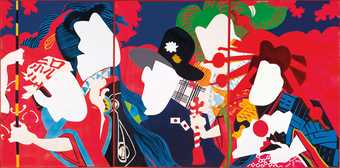Born 1932 in Tokyo, Japan. Lives and works in New York City, United States of America.

Ushio Shinohara with a new Oiran work in 1966
© Ushio and Noriko Shinohara
Photo © Hanaga Mitsutoshi
A founding member of the Japanese Neo Dada group (originally known as Neo Dadaism Organisers), Ushio Shinohara embraced pop art as early as 1963 with his Imitation Art series, a critical and provocative take on the work of American pop artists Jasper Johns and Robert Rauschenberg. These imitations – rough copies of works by the American artists – reflected on the notion of newness and originality in art, as well as on Japanese modern art’s relationship to Western art. Growing up in Japan during the Second World War, Shinohara witnessed the rapid Americanisation of his country. After inventing his famous Boxing Paintings in 1960–1, he gave up gesture-based painting and turned towards more mechanical means of production using new industrial materials and airbrush. Revisiting traditional Japanese art, from 1965 he developed a series of Oiran works imbued with pop’s aesthetics. Modernising the motif of oiran, a high-class courtesan traditionally depicted in woodblock prints from the Edo period (1603–1868), he adapted it to the context of pop art. Shinohara settled in New York in 1969 where he refused to partake in the minimalist and conceptual art movements, pursuing in the 1970s figurative works such as his series of cardboard-made Motorcycle Sculptures.
Presented at Ushio Shinohara’s debut exhibition Doll Festival at the commercial Tokyo Gallery in 1965, the Oiran series transformed traditional imagery into a groundbreaking body of work using fluorescent paint, plastic and aluminium sheets. His eponymous Doll Festival 1966 is emblematic of this series, with its pop treatment of the traditional subject. Although the faceless characters have been denied expression, their positions and attires in the painting introduce a narrative: the five figures are both actors and spectators of a scene withheld from the viewer. At the centre of the triptych, a man wearing a Western outfit is surrounded by four traditional Japanese figures: on the left a parade leader and a townswoman, and on the right a young male prostitute and an oiran. Inspired by the annual festival organised to pray for young girls’ growth and good development, Doll Festival reflects on the prevalence of symbols embedded in society at the time of modernisation and Americanisation of Japanese society.
Elsa Coustou
September 2015

